 An actor’s 30-hour research bender
An actor’s 30-hour research bender
By James Murray
 The question is this: As the sole performer in Praxis Theatre’s upcoming rail-inspired play Steel, how can I learn the requisite Canadian rail history without having to sift through Pierre Berton’s 496-page rail primer The Last Spike?
The question is this: As the sole performer in Praxis Theatre’s upcoming rail-inspired play Steel, how can I learn the requisite Canadian rail history without having to sift through Pierre Berton’s 496-page rail primer The Last Spike?
I’ve been listening to Gordon Lightfoot’s Canadian Railroad Trilogy, but I’m afraid that only serves as a small dose of inspiration. Clearly, I need a more adventurous research project.
Uncle Ridsy
With that in mind, I called Derek Ridsdale – an old Ottawa Valley high school chum. (Those in the know call him “Uncle Ridsy”. It’s an inside joke, and only a marginally funny one at that. Take it or leave it.)
These days Uncle Ridsy is based in London, Ontario, and has been working for Canadian Pacific Railway for 13 years. His family are fourth-generation railway workers. Coincidentally, one of the characters I play in Steel, George, is a fourth-generation steel worker – “making history with 10,000 tons of steel.” As it turns out, the semi-fictional George and the very real Uncle Ridsy have much in common.
Here’s another charcteristic they share: when Uncle Ridsy’s name comes up in discussions among friends, his charismatic and energetic storytelling ability is the gravitas around which our reminisces orbit. When he has a tale that sufficiently excites his interest, Uncle Ridsy is prone to standing up and waving his arms wildly in the air, acting out each nuance of his story. Steel‘s George has been written with a similar delivery in mind.
This parallel and divine coincidence provided an amazing opportunity for me. So I phoned him up: “Uncle Ridsy? It’s Jimmy Murray!”
“I’m doing research for a role. Can I come see you in London so you can tell me stories about the railroad? Please. Uncle Ridsy?”
His response: “Sure buddy! C’mon out fuck! I’ll tell ya everything ya need to fuckin’ know fuck! I’ll take ya out to the yard, put a maul in yer hand, you can drive all the fuckin’ spikes ya want!”
So I did.
Booze and steaks
I meet Uncle Ridsy at Yorkdale Mall in north Toronto for lunch at The Pickle Barrel. We both order ruben sandwiches. His wife, Melissa happens to be working in the Greater Toronto Area that day so she picks us up.
It’s a pleasant 90-minute drive from Toronto to London, with the music of “Guided By Voices” and “Tapes ’n Tapes” playing loudly in the background – a view of sunshine reflecting off the snowbanks and frozen trees. I fall asleep.
I awake in the parking lot of a liquor store in downtown London. Uncle Ridsy is slapping my knee.
“We need booze and steaks!” he says.
We obtain the provisions and head out to their cozy, suburban home. He calls it ‘The Ranch’. I receive a warm welcome from Jack and Charlie – a chihuahua-maltese mutt and a well-fed tabby cat, respectively.
Uncle Risdy gives me a quick tour of the house before we get down to business with the tunes, the Tuborg and the steaks.
I pull out my photocopy of the Steel script and my Praxis Theatre notebook.
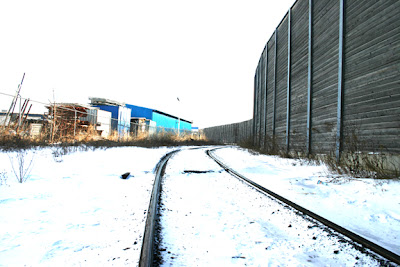 How to derail a train
How to derail a train
“First things first,” I say, “what’s a section gang?”
Uncle Ridsy begins: “Yeah, yeah . . . they’re the nuts, bolts and rail boys. The train can damage the track at any time, eh? So they send the gang out to repair it.”
That is, out to repair that particular ‘section’ of track . . . hence the name “section” gangs.
“How do they repair the track and what tools do they use?”
Temperature, apparently, is the problem.
When the temperature drops to -30°C during our harsh Canadian winters, the rails shrink and the nuts, bolts and spikes can fly out, explains Uncle Ridsy. In the summer, when it gets as hot as +30°C, the rail can be damaged by heat kinks, which can derail a train. No problem, he says, the section gangs use specialty tools like track jacks, track wrenches, spike mauls and tamping bars.
This technical line of inquiry goes on for some time. My questions and his answers becoming more arbitrary as one topic leads to the next.
Wow. Did I ever not know anything about how the railroad works.
Under the volcano
He fills me in about the track bed and how it used to be made of molten lava, which is apparently really harmful to the environment. Now they use chipped limestone they get from a plant up in Beachville, Ontario.
We cover the yard crews, which consist of a brake man, a conductor and an engineer. Uncle Ridsy goes off on a tirade about how one guy can put a mile-long train together by himself using a remote control beltpac.
I learn about the different types of cars: hoppers, flatbeds and gondolas. We even stage a scene from the play so I can understand the basic physics behind how the cars actually attach: the big metal hooks are called ‘couplings’ and when they attach, they call it the ‘knuckle’.
The more I ask him to specify, the more I get out of him.
What the fuck is an S&C box?
The biggest challenge comes when he tries to elucidate the systematic procedures of the ‘Signals and Communications Dept.’ or S&C box, which is his current placement. He is a signalman, stationed in a small box or bungalow somewhere along the endless miles of track. The S&C box stores a multitude of current relays, a rectifier that converts alternate current (AC) to direct current (DC) and a bank of batteries.
It took Ridsy almost 13 years to learn how to operate this highly sophisticated control system, forgive me if I can’t go too deeply into it here.
Uncle Ridsy and the poem
My next set of questions pertain specifically to excerpts from the script. For this to work, poor Ridsy has to interpret the script’s poetic description of the signalman job:
“I tried to write freelance but they offered me steady money, tied to the nexus of ten thousand steel roads, calibrating signals: it’s a little glass box with a solenoid coil and when you run a current through it, it pushes against a spring and makes a connection: electric violence, caged, a thunderbolt bent double.”
Boy do we ever sweat with this one. Uncle Ridsy fights like a pitbull trying to decipher this poem and the whole system for me. He’s madly scribbling diagrams all over my notebook and his phone bill. When we finally reach a slight level of satisfaction, he says, “Steak’s ready!”
We eat, drink, listen to some more fine music then cab down to Scott’s Corner Pub for a nightcap.
A broken knuckle
The next day Ridsy takes me on a all-access tour of the railyard.
I’m playing with all these 25 lb. tools and get a tour of an actual S&C box, at which point Uncle Ridsy gets all worked up again trying to explain the details of the various switches and levers. Then he shows me the car attachment devices: the coupling, hot shot and knuckle. It makes me think of a particularly grisly scene from the play . . . holy shit!
As we’re driving out, I see a broken knuckle on the ground.
“Stop,” I say, “I wanna grab that. That’d be perfect for the set!”
“Dude, it’ll rip through my fuckin’ car!” Uncle Ridsy says. “Weighs about 400 lb.!”
Are you on the bus or are you off the bus?
Ridsdale, Melissa and I top off the trip with dinner at a Vietnamese-Thai fusion place. I climb on the 8:30 pm Greyhound with a belly full of pad thai and pass out. It was 30 hours well spent.
As an actor trying to understand the inner workings of the Canadian rail system for a part, this trip to London helped immensely. It gives me insight into what the characters in the play are talking about and what they’re going through.
I’m sure Andrew Zadel would have been happy to fill in the blanks, but – you’ve heard – our playwright’s in the Congo.
Andrew. Come back. Your play misses you.
 How to write a play
How to write a play
By Andrew Zadel
Some guy once said, “I am not a writer except when I write”. So, according to that guy, I have not been a writer for quite some time, but instead am just a stodgy international civil servant with a profound, unshakeable and yet completely uninspiring sense of self-loathing. And I trust that guy – whoever the fuck he is. He seems to know a lot about me.
My psychic told me that in a former life I was a playwright and musician in Montreal. But now I work for the UN in The Democratic (and hot) Republic of Congo, right on the Rwandan border. In the last two months the area has seen a major volcanic eruption, massive rebel military advances with concomitant thievery and sexual violence, and the displacement of 100,000 people.
I have written all about it: daily reports, weekly reports, monthly reports . . . it’s kind of like being a secretary in hell. Lots of reports. No play. Ever seen The Shining?
Anyway, despite the Sisyphean office purgatory that actually briefly robbed me of my ability to walk due to the complete atrophying of my back muscles, no one can dispute the fact that I wrote this play called Steel that is going to be performed in Toronto in March by the handsome and talented James Murray.
Other than that, my only connection to the Toronto arts scene is my obsessive and repetitive consumption of the latest offerings of all-girl power trio Magenta Lane. If I can convince the drummer to go see the play, it will be almost like being “on the scene” – in a 21st century “I have given my body to the Internet” kind of way.
This social amputation is almost fitting, however, given that Steel was always written in isolation. The first round was staring out the window of a VIA train from Vancouver to Toronto. The landscape made it onto the paper, but there was hardly a play there.
Luckily, as some kind of slow-burning investment, my dad had bought a condo in the marshy retirement community of Alexandria, Ontario. I locked myself in there for a week with five boxes of cereal, a book about turn-of-the-century railway work gangs, and somebody’s PhD thesis about tourism on the Queen Charlotte Islands. I forbade myself from walking over to the Tim Horton’s, lest I lose a day or two hanging out with bored rural high school kids. My only human contact was listening one night to someone screaming and sobbing violently outside the neighbouring hospital.
So, as planned, I was left with no other options and I wrote. And I wrote and I read and I wrote some more. And then I deleted, and I deleted some more. Art is communication, and I was stuck talking to myself in an unfinished apartment overlooking a Canada geese breeding ground. If you press the delete key often enough, you can even erase the words from inside your stomach.
So the play got written, but only after I made it back to my fellow human beings. There is definitely a small part of my soul that was eaten by Alexandria, Ontario. But at least it seems to have been spat back into the text: the grandfather I knew only as a pair of calloused hands offering me bubblegum, the raw and unfinished country I have wandered from time to time, the eight-foot beams I stacked under summer sun in a Montreal rail yard . . .
I guess that’s why people like this play – because it is about all of us. It’s about getting out of bed every day and doing shit that you don’t want to do, because people expect things from you and you’re standing there staring at a table with no bread on it. You gotta do what you gotta do. You can’t just pack it all in and be a playwright. right?
Okay, back to work. Reports to be written. Somebody eat a snowflake for me.

 It’s a pickaxe, stupid
It’s a pickaxe, stupid
By Ian Mackenzie
Your regular Steel diaries correspondent, Michael Wheeler, has kindly allowed me to hijack this week’s post in order to bring you a message from the front lines of the show’s marketing campaign.
It’s a message that involves 12 image files (including the intro shot, above) and judicious use of the word “PhotoShopped”. Mostly, this entry into the Steel diaries is about process, which makes it right at home among Michael’s other entries.
The challenge
As part of our marketing strategy for Steel, we’ve arranged to place ads for our show in the programs of a couple of other productions. The nice people at Stranger Theatre, for example, agreed to run a Steel ad in their and what Alice found there program. But since we’re still a few months away from our show’s March run, we hadn’t yet given a lot of thought to the design of our promotional poster and postcard, nor do we have a graphic designer on board to help with such endeavors.
So, with limited resources we set out to build the ad ourselves. The upside is quick turnaround. The downside is diminished quality and limited expertise.
The iconography
We knew, from marketing a previous workshop version of the show, that the pickaxe was a strong icon to work with.
 Promotional shot from an earlier production of Steel.
Promotional shot from an earlier production of Steel.
The pickaxe relates nicely to the content of the play, and it’s also a strong visual motif.
 Another promotional image from an earlier production of Steel.
Another promotional image from an earlier production of Steel.
(Steel playwright Andrew Zadel with pickaxe.)
Instead of trying to reinvent the wheel for this latest incarnation of the show, we agreed to keep working with the pickaxe image.
This is our new pickaxe:
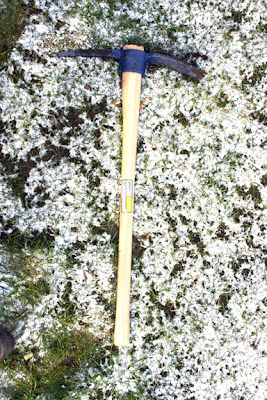 Pickaxe from ML Lumber & Building Supply: $31.16
Pickaxe from ML Lumber & Building Supply: $31.16Putting it together
We started with this hastily taken image:
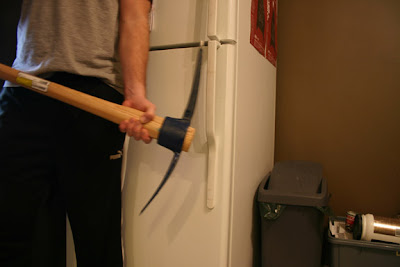 Scary.
Scary. To soften the impact of the aggressive-looking pickaxe and to contextualize it with the railroad, we pulled this image off the Internet:
 We don’t own the rights to this image.
We don’t own the rights to this image.
We “PhotoShopped” the two images together . . .
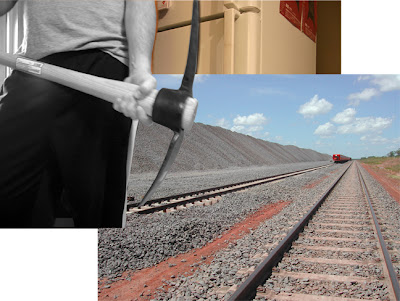 . . . stripped out the colour and cropped the image to the ad’s specifications (3.9 x 4.9).
. . . stripped out the colour and cropped the image to the ad’s specifications (3.9 x 4.9).
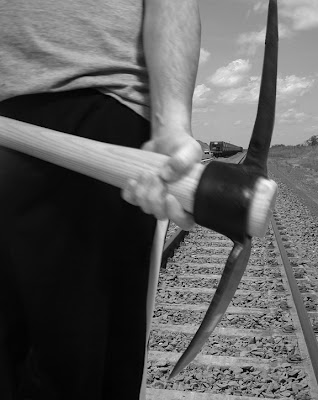
We tried to include our logo, but given the composition of this ad, we would have had to run the logo in reverse (i.e., white logo on black background).
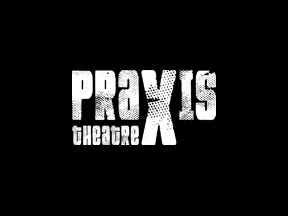 It just looks muddy.
It just looks muddy. Because of the distressed treatment of the type, our logo doesn’t look good when reproduced in reverse in small scale. (For more info on our logo, please feel free to check out our logo’s usages guidelines here.) And while we don’t like the idea of running an ad without our logo on it, we made the executive decision to leave it out of this piece.
Finally, we added our text.
You’ll notice that we’ve applied a blur effect to the figure in the foreground.
No masterpiece, but it gets the job done.
With only minutes to spare on our deadline, we sent it off to our contact at Stranger Theatre only to discover we’d built the ad to the wrong orientation.
Here’s the recut, landscape-oriented version:
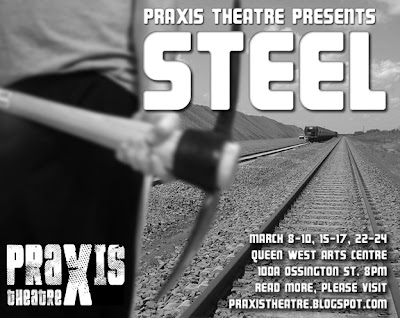 Landscape orientation allowed us more room to use our logo.
Landscape orientation allowed us more room to use our logo.The ad saw its first light of day at the premier of Stanger Theatre’s and what Alice found there.
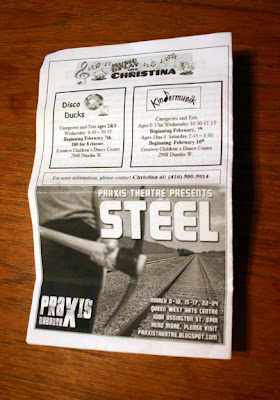 Here’s the final ad in Stranger Theatre’s program.
Here’s the final ad in Stranger Theatre’s program.
Much thanks to Kate Cayley and Lea Ambros for the great back cover placement!
(BTW, and what Alice found there runs until February 4. Check it out if you can.)
Seeing our ad hard at work at the premier of Stanger Theatre
’s show reinforced for us the power of swapping program ads. Our show is still a couple of months away, but getting the word out early, and often, can only increase the show
’s profile and support us when we arrive at the difficult task of getting those proverbial bums in seats.
Lessons learned
1. Decide on and stick with a consistent visual motif.
2. Always verify your ad’s orientation (landscape or portrait) before you start.
3. Make sure to include your logo in your ad.
4. Ad swapping is a great way to dramatically increase media impressions.
5. Use the word “PhotoShopped” sparingly.
This is only a prototype
We’re hoping this initial foray into Steel’s marketing campaign will provide the inspiration for a more professional execution as we draw closer to the show.
I like the basic idea and composition used here. I think we may be able to find a more suitable typeface, develop a colour version, use our actor, James Murray, as the model, find a solution to our logo woes, and generally tweak the layout.
If you’re in Toronto over the next few months and happen to see a poster or program ad with a pickaxe on it, please think of us and our show and these beginnings to our marketing campaign.
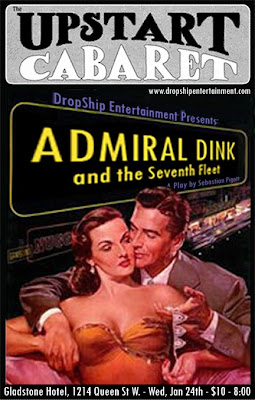 Upstart Carbarets are always fantastic events thanks to DropShip’s signature combination of theatre, music, comedy and dancing. DropShip Entertainment not only offers a live theatre experience, they also build an excellent party around it.
Upstart Carbarets are always fantastic events thanks to DropShip’s signature combination of theatre, music, comedy and dancing. DropShip Entertainment not only offers a live theatre experience, they also build an excellent party around it.
UPSTART CABARET IV:
Admiral Dink and the Seventh Fleet
Wednesday, January 24th
Gladstone Hotel
1214 Queen St. W.
$10 online @ DropShip Entertainment
$15 @ the door
Doors open at 8:30, curtain at 9.
Written by: Sebastian Pigott
Directed by: Mac Fyfe
Featuring: K. Trevor Wilson, David Tompa, Sebastian Pigott,
Kate Gordon, Andrea Ramolo, Jason Gray and Brenhan McKibbon.
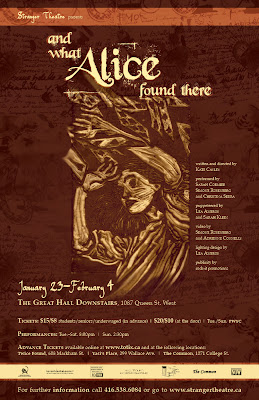 The work:
The work:
Stranger Theatre’s and what Alice found there is an exploration of the encounter between the eccentric genius Lewis Carroll and Alice Liddell – the girl who served as the inspiration for his greatest work.
The company:
Stranger Theatre has performed to audiences in Pittsburgh, Philadelphia, New York City, Halifax, and will now receive a production in Toronto for the first time at the The Great Hall Downstairs, 1087 Queen St. West.
The story:
and what Alice found there brings to life Lewis Carroll’s writing of Alice in Wonderland, the real Alice, and the world in which they lived. Using a mixture of sources from Carroll’s two famous novels, letters and other writings, we begin with a sunny day on the river and travel to far darker places. The story examines childhood, love, and the nature of creation. Alice Liddell’s journey through Victorian times mirrors Alice in Wonderland’s journey through the hallucinatory landscape of her author’s imagination, where nothing is as it seems.
The creative team:
Written and directed by Kate Cayley, performed by Sarah Cormier, Simone Rosenberg, and Christina Serra. Puppeteered by Lea Ambros and Sarah Klein. Video by Simone Rosenberg and Adrienne Connelly. Puppets designed and built by Kate Cayley and Lea Ambros with lighting design by Lea Ambros.
The information:
Tuesday, January 23 – Sunday, February 4
Tuesday to Saturday at 8:00pm & Sundays at 2:30pm
The Great Hall Downstairs
1087 Queen St. West. at Dovercourt Rd.
Tickets: Advance – $15/$8 (students/seniors)
At the door- $20/$10. Tuesdays and Sundays pay-what-you-can.
Special $6 tickets for performances on January 24 and 25 shows available for students under 25 through HipTix (go to T.O.TIX website)
For tickets:
Advance tickets available online through T.O.TIX and at the following locations:
Twice Found – 608 Markham St.
Yasi’s Place – 299 Wallace
The Common – 1071 College
For general information call 416-538-6084 or visit the Stranger Theatre website.
 The playwright’s in the Congo, the theatre’s in the alley
The playwright’s in the Congo, the theatre’s in the alley
By Michael Wheeler
The really friggin’ fantastic news is that we know when and where the show will be going on:
March 8th-10th, 15th-17th and 22nd-24th
The Queen West Arts Centre – 100A Ossington St.
(It’s just north of Queen Street)
All shows at 8pm
How did all of this come about, you ask?
Well Dave Galpern, who works with The Classical Theatre Project and The Toronto Youth Theatre, is an old friend. We did shows together at Montreal’s McGill Universtiy in the 90s and he played Koroviev in the Praxis Theatre production of The Master and Margarita.
His space on Ossington has thus far been used as a rehearsal centre for his two companies before their shows open at the Young Centre, Hart House . . . what have you. The thing is, the largest of these rehearsal spaces would also make a great, I mean really fabulous, theatre. It should have its own name. It is yet to be named. High ceilings, lots of room, obviously its proximity to all the shit going on down on Queen West makes for a pretty great location, too. So we made a deal and that’s where Steel will go on.
Now the tricky part is, there isn’t anything else to work with. So, we have two projects now:
1) putting a play together; and
2) putting a theatre together.
Should be no problem. Oh wait – we have no money and very limited free time. Could be a problem. Will definitely be interesting regardless.
Anyone reading along who has access to lights, blacks or chairs should be in contact at this point. Please. We have free program ad space, multiple tickets, and our undying gratitude and appreciation to offer.
Have I mentioned that the playwright is somewhere in the jungles of the Congo reporting on human rights violations for the UN? I wonder how those rewrites are going?
Tomorrow is our first official rehearsal. We aim to have a strong grasp of what the F we are up to by the end of the month so we can put the whole thing together with vigour in February. Rehearsals are, of course, in Jimmy’s living room. This is one of the benefits of the one-man show.
On the creative end of things, the team had a long discussion the other night about whether or not we need a set designer. We didn’t get anywhere.
Maybe once we have a better idea of our resources and approach this time around, we’ll know whether we’re in over our heads in this element or not.
And publicity, oh publicity. What are the myriad of ways we can get people, and reviewers, whose reviews would bring more people out to see this one-man show at a venue nobody has heard of that we just invented? Publicity could have its own blog. But that may be too meta-narrative. We’d have to start a blog about having a blog.
But we do have a place . . . and a date . . . and an actor . . . and a script . . . so hey, the rest is just details, right?
We asked:
I would go to more independent theatre if . . .
You said: In-depth analysis:
In-depth analysis:
First, the easy stuff. According to these results, big name actors, clear distinctions between companies and comedic theatre all rate low on people’s list of independent theatre expectations.
Cost seems to be a factor among only a minority of respondents: one person wants lower ticket prices, another wants money-back guarantees.
Two people voted for improved marketing materials. (More on this below.)
And another two said they want productions that are more accessible (presumably in regards to a production’s content).
These numbers are hardly conclusive, but as we move toward the higher-rated options, we see clearer definition in the responses and – by design – greater consensus.
The winners:
Given the format of this poll, we’re not sure the most popular answers qualify as “winners”. Let’s, instead, call this “insight”.
The insight:
Four respondents expressed a desire for increased quality in their independent theatre experience. There’s obviously a discussion to be had about what exactly is meant by “quality” and how to achieve it. Maybe we can put this one into our 10 questions rotation: “What do you think is the single greatest barrier to producing quality independent theatre?”
Another four respondents expressed interest in being able to buy tickets for a bunch of shows at one time.
But the most popular response to our survey was from people who feel they need to know more about independent theatre: What is independent theatre? What makes it independent? What are the benefits of independent theatre over mainstream and established theatre? How do I know which shows to go to?
Maybe there’s a link between this knowledge gap and the respondents who felt that marketing materials need to improve.
Obviously, this survey raised many more questions than it answered. But one thing seems clear: the more people we can entice into our theatres, the more work we’ll be able to produce. If there’s a gap between what independent theatre artists are doing and public perceptions of that work, its seems a worthwhile pursuit to examine our communications strategies with renewed vigour.
If anyone has further thoughts on this, let’s continue the discussion.
First, a round of thank yous is in order . . .
Thanks to everyone who helped make 2006 a banner year for Praxis Theatre. Our production of The Master and Margarita at the Toronto Fringe Festival was the culmination of three years of workshopping, blood, sweat . . . tears, beers and Russian-adaptation fears. We’re very proud of the work and the entire team that helped make that show the success it was.
Thanks also go out to the other theatre companies, artists and producers who put on their own shows and events. Thank you to the kind folks who actually went to see and support independent theatre in 2006. And just before we all drown in thank yous, we’d also like to extend our appreciation to everyone who has contributed to this blog.
Thanks! You rock, generally.
2006 was a banner year for Praxis Theatre in many ways – new team members, more community outreach, innovative fundraising – but a lot of it had to do with positioning the company for a bright and productive future.
So, what the fuck is next?
We are excited to welcome the new year with an ever-expanding calendar of events that include our upcoming one-man show (Steel), an elegant fundraiser, our ongoing playwrights’ reading series, and much, much more.
As for this blog, we’re looking to expand and refine our offering. In 2007, we’ll be bringing you more great interviews from our 10 questions series, more from The Steel Diaries, more and better surveys, a ton of surprises as well as expanded events notices.
If you have an upcoming event that you’d like to let people know of, please drop us a line with details and we’d be happy to post it here. We’re open to pretty much any and all ideas. And if you have any thoughts on how we can make this blog a more useful service, please pass those along too.
Throughout 2006, we made some great connections. The independent theatre scene in Toronto is brimming with talent. It’s been our privilege to meet and work with some of the best. Let’s use 2007 to strengthen the networks that link us and move forward to produce the best work we can.
See you at the theatre!
Signed,
The Praxis Theatre team.
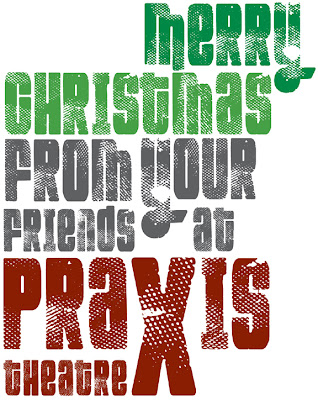
 An actor’s 30-hour research bender
An actor’s 30-hour research bender The question is this: As the sole performer in Praxis Theatre’s upcoming rail-inspired play Steel, how can I learn the requisite Canadian rail history without having to sift through Pierre Berton’s 496-page rail primer The Last Spike?
The question is this: As the sole performer in Praxis Theatre’s upcoming rail-inspired play Steel, how can I learn the requisite Canadian rail history without having to sift through Pierre Berton’s 496-page rail primer The Last Spike? How to derail a train
How to derail a train










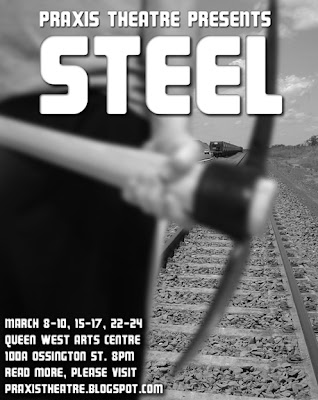





Recent Comments